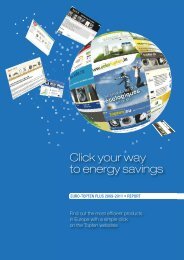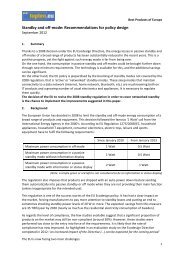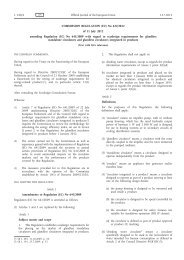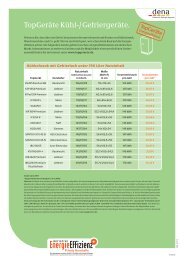Energy efficient room air conditioners - best available ... - topten.eu
Energy efficient room air conditioners - best available ... - topten.eu
Energy efficient room air conditioners - best available ... - topten.eu
You also want an ePaper? Increase the reach of your titles
YUMPU automatically turns print PDFs into web optimized ePapers that Google loves.
<strong>conditioners</strong>. The most energy <strong>efficient</strong> split <strong>air</strong> <strong>conditioners</strong> have a variable frequency drive (VFD)<br />
and a permanent-magnet motor. The VFD allows the <strong>air</strong> conditioner’s compressor to run at part load<br />
and adapt its workload to the temperature change needed. Fixed speed <strong>air</strong> <strong>conditioners</strong> on the other<br />
hand reach a certain temperature by switching from full load operation to off, which is not very<br />
<strong>efficient</strong>.<br />
The current EU energy label for <strong>air</strong> <strong>conditioners</strong> refers to the <strong>Energy</strong> Efficiency Ratio (EER, cooling<br />
function) and Co<strong>efficient</strong> Of Performance (COP, heating function) to indicate the energy efficiency of<br />
<strong>air</strong> <strong>conditioners</strong>. These indicators are measured at full load operation and do not account for the<br />
efficiency gains by the variable speed drives’ ability to work at part load. Seasonal efficiency<br />
indicators (SEER for cooling, SCOP or Heating Seasonal Performance Factor (HSPF) for heating) do<br />
consider the different cooling or heating needs during the year and include part load operation of <strong>air</strong><br />
<strong>conditioners</strong>. Many non-EU countries have been applying seasonal efficiency indicators, while the EU<br />
is about to introduce them now.<br />
Air conditioner markets in Europe and China: trends, <strong>best</strong> <strong>available</strong><br />
technology (BAT) and energy consumption<br />
Europe<br />
Market trends<br />
Annual <strong>air</strong> conditioner sales in the EU are expected to grow from 4.9 million units in 2005 to almost 10<br />
million by 2020. At the same time the stock will increase from around 40 million units to 110 million<br />
installed <strong>air</strong> <strong>conditioners</strong> [2].<br />
National markets across the EU differ strongly due to different climate, building design, legislation and<br />
income. In Southern countries for instance heating with <strong>air</strong> <strong>conditioners</strong> is common, while houses in<br />
Northern countries usually have central heating installed. Across Europe, about 75% of the sold <strong>air</strong><br />
<strong>conditioners</strong> include a reversible heat pump capable of cooling and heating. Variable speed (inverter)<br />
<strong>air</strong> <strong>conditioners</strong> have also become popular: in 2007 55%-75% of the sales were <strong>air</strong> <strong>conditioners</strong> with a<br />
variable speed drive. Sales shares of both reversible heat pumps and variable speed <strong>air</strong> <strong>conditioners</strong><br />
are expected to grow further, while split cooling only appliances (without heating function) are<br />
expected to disappear from the market. Single ducts and double ducts, today accounting for about<br />
15% of the sales, are expected to become more popular however [2].<br />
Sales data from 5 European countries from 2005 - 2008 (till October) show that class A <strong>air</strong><br />
<strong>conditioners</strong> by now account for most of the sales (Fig. 1).<br />
!<br />
Figure 1: Air conditioner sales in 5 EU-countries (France, Germany, Italy, Poland, Great Britain)<br />
2004 – October 2008. Source: GfK data in [3].!<br />
2










